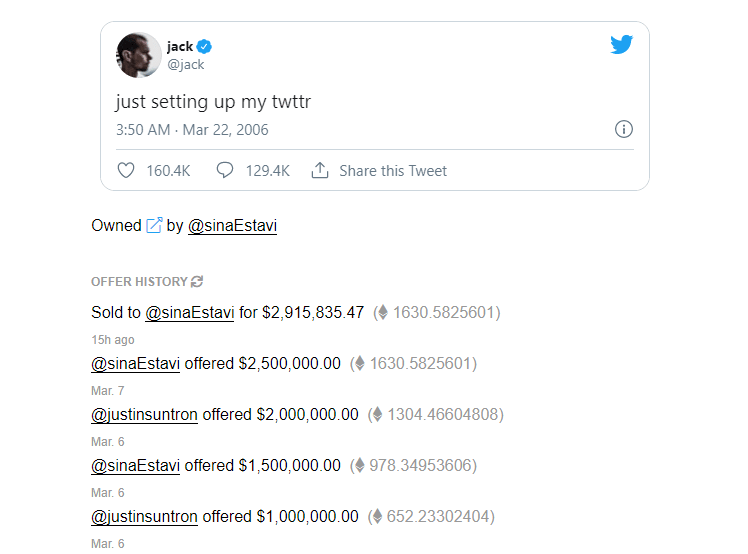An NFT(non-fungible token) is a a digital asset on a blockchain that allows for guaranteed proof of organization and ownership of music, videos, images and even text. In other words, it is a permanent tracking device that proves ownership of a digital file, or could be seen as a cryptographic token connected to a digital asset to preserve ownership rights in the metaverse.
Digital art is becoming something else.
On the 11th March 2021, Vignesh Sundaresan commonly known as Metakovan, an Indian cryptocurrency investor, bought Beeple's Everydays: The First 5000 Days (a collection of his digital art) for $69 million in cryptocurrency. It was the first NFT sold at auction, the most expensive NFT ever sold and one of the 20 most expensive works of art ever sold at auction. The auction, artwork and currency were all virtual, but their transaction was real.
Crypto entrepreneur Sina Estavi bought Twitter founder Jack Dorsey's first-ever tweet just setting up my twttr as an NFT for $2.9 million last year. Now, it is worth only about $14,000 or less, as a result of the reflection of a maturing NFT market.
NFTs are not only lucrative, but also represent the strength in the relationships we have with the public.
Usually, an NFT starts from a digital file. The creator of an NFT adds another layer of code on it and that code registers that file on a blockchain. The value of that NFT is found in its uniqueness, and although anybody can buy it, it does not change the fact that the original owner still remains the primary owner of his/her art.
An artwork is a digital file, and to protect it and capture the value of your labor in perpetuity, you go to a digital goods marketplace like OpenSea, and "mint it"(register it as a token for a fee between $70 and $300 on blockchain). After minting, it will contain your signature, your time stamp, and any rules around its resale. After minting, it becomes ready for sale. Connect with your community and let them know that it has dropped; meaning that it's for sale. This has to do with creating a strong bond with your clients, which is advantageous because there is no middleman or intermediary between you and your audience. Usually, clients are attracted to art that have a high chance to be sold at an even higher price in the future. Your client purchases your NFT when he is convinced enough, and stores it in his digital wallet.
The underlying decentralized technology that enables digital currencies is blockchain. Blockchain prevents digital money from being duplicated or hacked, and it removes the need for a centralized authority(such as a bank) to validate transactions. The record of ownership of an NFT is kept in a public database on the Internet that is maintained by millions of computers that keep track of all content origination and transactions.
NFTs in futurism
In the metaverse, humans are represented using avatars, and you can buy clothes for your avatar as well. Fashion companies have started diving into the metaverse. For example, Gucci sells sneakers that only exist in the virtual world, and you can never wear them; but your avatar can. Alternatively, you could use augmented reality to overlay virtual sneakers onto your real feet. Gucci has gone as far as offering land in The SandBox, a gaming platform. Nike bought virtual sneaker designer RTFKT (pronounced "artifact") on the 13th of December 2021. Now, over $11 million has been spent on its first virtual sneaker set.
It has been said that online dress up games have used its users to dress up their models for them to sell out the clothes as NFTs for use in the metaverse. A lot of people and companies have seen the future from Zuckerberg's point of view and have started amassing sounds, images, videos and even text for use in the future. Statistics show that at a particular point, in a world of evolving technology, humans will no longer be able to live without experiencing a digital world. So, companies have started piling up a huge amount of art to sell at very high rates during those periods.
Not only have NFTs provided a way for people to interact in a virtual world, but it serves as a huge source of income to artists, who in the past were considered as a set of people who gave out joy to others using their imaginations, with almost nothing in return. And because of NFTs, anyone can create digital fashion to be bought, sold and worn in games, online platforms, and even in avatar fashion shows and musical concerts.





Top comments (0)